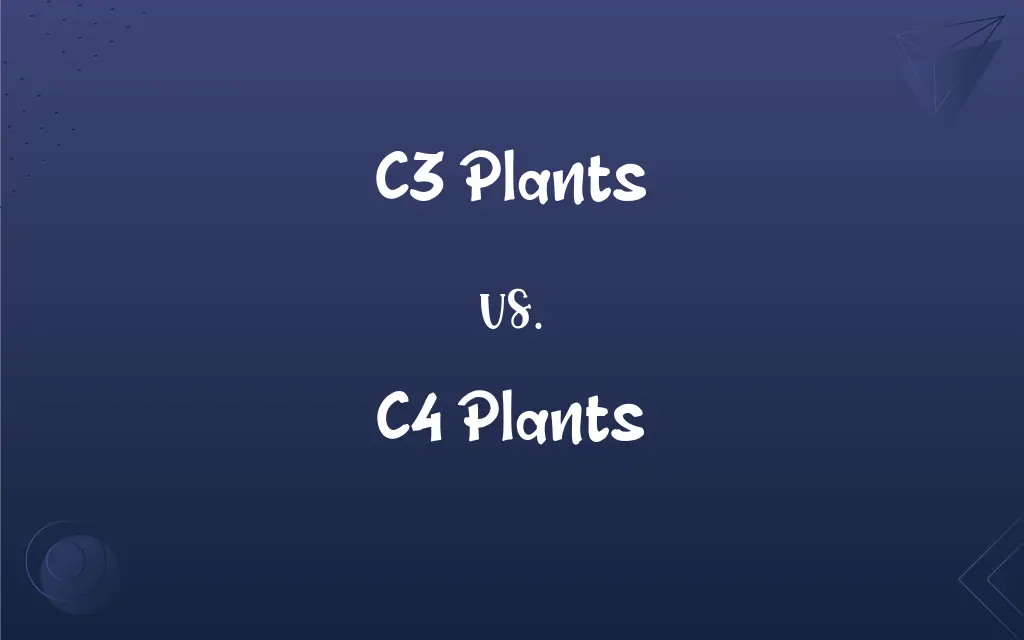C3 Plants vs. C4 Plants: What's the Difference?
Edited by Janet White || By Harlon Moss || Updated on October 9, 2023
C3 plants use the Calvin cycle for the fixation of CO2, while C4 plants minimize photorespiration by fixing CO2 in a separate cell before the Calvin cycle.

Key Differences
C3 plants utilize a straightforward method of photosynthesis, where carbon dioxide is fixed in a 3-carbon compound. The primary fixation of carbon, in the form of CO2, occurs through the Calvin Cycle and produces a 3-carbon compound, 3-phosphoglycerate. C4 plants, on the other hand, are developed to withstand hot and dry environments with their advanced photosynthetic mechanism, whereby the CO2 is first incorporated into a 4-carbon compound, oxaloacetate.
Both C3 and C4 plants differ markedly in their response to atmospheric CO2 and how they manage the critical challenge of photorespiration. C3 plants tend to lose their effectiveness in photosynthesis as they conduct photorespiration, especially when the CO2 concentration is low and oxygen concentration is high, for instance, under hot and dry conditions. Contrastingly, C4 plants show an adaptive mechanism where they separate the initial CO2 fixation and the Calvin cycle in different cells, which helps them to minimize the losses from photorespiration.
Regarding their anatomical structure, C3 plants do not have specialized anatomy to support the separation of initial CO2 fixation and Calvin cycle, conducting both processes in the same mesophyll cells. In the converse, C4 plants exhibit a distinct "Kranz" anatomy, where the mesophyll cells, where CO2 is first fixed, form a ring around the bundle-sheath cells, where the Calvin cycle and subsequent fixation of CO2 occur, maintaining a high concentration of CO2 around the Rubisco enzyme and minimizing photorespiration.
The geographical and environmental distribution of C3 and C4 plants also presents a fascinating distinction. C3 plants are generally found in areas with moderate sunlight intensity and temperatures, and they usually dominate in regions with adequate water availability. In contrast, C4 plants are typically found in tropical, subtropical, and warm temperate regions where high temperatures and light intensities prevail, utilizing their specialized photosynthetic pathway to maximize water-use efficiency and minimize photorespiration, granting them an adaptive advantage under these conditions.
Comparison Chart
Primary Carbon Fixation Compound
3-carbon compound (3-phosphoglycerate)
4-carbon compound (oxaloacetate)
ADVERTISEMENT
Photorespiration
Higher rates, especially in hot and dry conditions
Significantly reduced due to spatial separation of CO2 fixation and the Calvin cycle
Anatomical Specialization
Lack specialized Kranz anatomy
Exhibit Kranz anatomy, with separated mesophyll and bundle-sheath cells
Typical Environmental Conditions
Prefer moderate light and temperature conditions
Often found in hot, high-light, and/or arid environments
Geographical Distribution
Widespread, including cooler climates
Typically in warm, tropical, and subtropical regions
C3 Plants and C4 Plants Definitions
C3 Plants
Classic Photosynthesizers
C3 plants, such as wheat, perform photosynthesis in the traditional sense, involving the Calvin cycle.
ADVERTISEMENT
C4 Plants
High-Temperature Navigators
In the scorching summer heat, C4 plants, such as sugarcane, maintain efficient photosynthesis due to their specialized pathway.
C3 Plants
Photorespiration Performers
Unlike C4 variants, C3 plants undergo notable photorespiration, especially under high light and temperature conditions.
C4 Plants
Tropical and Subtropical Dwellers
In the vast savannas of Africa, C4 plants dominate the landscape, thriving in the hot and bright environmental conditions.
C3 Plants
Single-Cell Fixers
C3 plants fix and reduce CO2 within the same mesophyll cell, simplifying their carbon assimilation process.
C4 Plants
Photorespiration Minimizers
C4 plants, like corn, significantly minimize photorespiration by initially fixing CO2 in a separate cell.
C3 Plants
Cool Climate Thrivers
The C3 plants often flourish in environments where there is ample water and moderate temperatures.
C4 Plants
Arid Zone Bloomers
C4 plants, including many grasses, prosper in arid environments by optimizing water-use efficiency through their distinct photosynthetic mechanism.
C3 Plants
Extensive Cultivators
A variety of crops, such as rice and oats, are C3 plants, cultivated extensively worldwide.
C4 Plants
Anatomically Specialized Flora
The structured Kranz anatomy of C4 plants allows them to precisely regulate and concentrate CO2, enhancing photosynthetic efficiency.
FAQs
What characterizes C4 plants?
C4 plants fix CO2 into a 4-carbon compound, separately from the Calvin cycle, minimizing photorespiration.
What role does photorespiration play in C3 plants?
It reduces the efficiency of photosynthesis by utilizing O2 and releasing CO2.
Are C3 plants efficient in water usage during photosynthesis?
C3 plants are generally less water-use efficient compared to C4 plants, especially under hot and dry conditions.
How do C4 plants minimize photorespiration?
They spatially separate initial CO2 fixation and the Calvin cycle, reducing oxygen’s interference.
Which plant type dominates cooler climates?
C3 plants generally dominate in cooler climates due to their relative efficiency under moderate conditions.
Can C3 plants adapt to warmer climates?
C3 plants can be found in warmer climates but may exhibit reduced photosynthetic efficiency due to increased photorespiration.
Is rice a C3 or C4 plant?
Rice is a C3 plant.
What is the significance of the Calvin cycle in C3 plants?
The Calvin cycle is essential for fixing CO2 directly and is the sole pathway for CO2 fixation in C3 plants.
Are C4 plants common in arid regions?
Yes, C4 plants are common in arid regions due to their water-use efficiency.
Do C4 plants function well in low light conditions?
C4 plants are generally less efficient than C3 plants under low light conditions.
What is the primary disadvantage of C4 plants compared to C3 plants in certain conditions?
C4 plants can be less efficient than C3 plants under cool and low-light conditions.
How does temperature affect C3 plants’ photosynthetic efficiency?
Higher temperatures often reduce C3 plants’ photosynthetic efficiency by increasing photorespiration.
What defines a C3 plant?
C3 plants fix CO2 directly via the Calvin cycle, forming a 3-carbon compound.
Which crops are examples of C4 plants?
Maize (corn), sugarcane, and sorghum are examples of C4 plants.
Can C3 plants be found in tropical regions?
Yes, C3 plants can be found in tropical regions but may be outcompeted by C4 plants under very hot and bright conditions.
What is Kranz anatomy, and which plants have it?
Kranz anatomy refers to the structural arrangement of cells in C4 plants that separates two stages of photosynthesis.
Is corn a C3 or C4 plant?
Corn is a C4 plant.
How do C4 plants adapt to stressful environmental conditions?
C4 plants adapt by effectively minimizing photorespiration and optimizing water use in hot and arid conditions.
Do C4 plants perform the Calvin cycle?
Yes, C4 plants perform the Calvin cycle, but it is separated from the initial CO2 fixation, occurring in different cells.
Which crops are examples of C3 plants?
Wheat, rice, and oats are common examples of C3 plants.
About Author
Written by
Harlon MossHarlon is a seasoned quality moderator and accomplished content writer for Difference Wiki. An alumnus of the prestigious University of California, he earned his degree in Computer Science. Leveraging his academic background, Harlon brings a meticulous and informed perspective to his work, ensuring content accuracy and excellence.
Edited by
Janet WhiteJanet White has been an esteemed writer and blogger for Difference Wiki. Holding a Master's degree in Science and Medical Journalism from the prestigious Boston University, she has consistently demonstrated her expertise and passion for her field. When she's not immersed in her work, Janet relishes her time exercising, delving into a good book, and cherishing moments with friends and family.































































